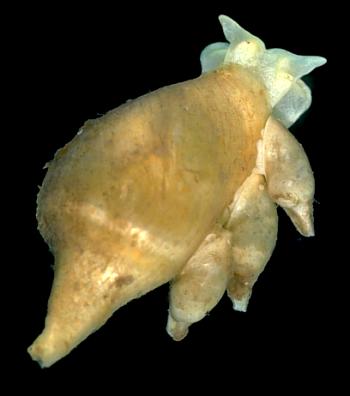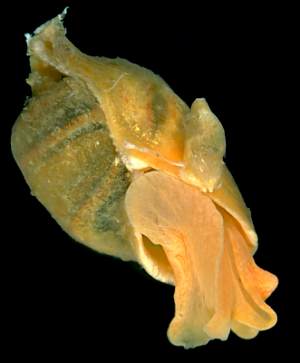Volvatella vigourouxi - dwarf males or impetuous youth?
July 11, 2002
From: Bill Rudman


Kathe Jensen recently reported (1997) small animals riding on the shell of Volvatella ventricosa waiting to copulate. I have have observed this a number of times in Volvatella vigourouxi, including these examples from Koumac in northern New Caledonia.
PHOTOS:
UPPER: Koumac Beach (=Baie de Ouanap), near Koumac, New Caledonia, 20°34'S, 164°16'E, mixed soft and hard substrate, grassbeds, algae, 23 October 1993, 5 specimens, AM C200605.
LOWER: Baie de Koumac, Koumac Region, New Caledonia, 20°34.5'S, 164°15.5'E, 3 m, sandy mud, Caulerpa beds, 10 October 1993, 8 specimens (3.5, 5, 6, 13, 20, 20, 21 & 22mm long alive), AM C200412. [In all cases the lengths are shell lengths]. PHOTOS: Bill Rudman.
When the large animal [AM C200605] in the upper photo was collected it had one dwarf male on the lip of the shell aperture, but when it and and a number of other small individuals were kept together in a dish, all the small animals crawled on to the shell of the large animal, at one time 4 taking up positions along the lip of the aperture. (only 3 in this photo)
The lower photo [AM C200412] represents the 'typical' position with one dwarf male on the edge of the aperture. In this case three out of five large animals collected had dwarf males [21mm - 6mm; 13mm - 3.5mm; 20mm - 5mm] sitting right at the edge of outer lip. To check I attempted to remove one small animal and it was definitely copulating with its penis extending down into its partner's mantle cavity.
Opisthobranchs are considered to be hermaphrodites with functional male and female reproductive organs. There are certainly examples of opisthobranchs in which the male system develops before the female ovary [protandry] and their are many examples amongst other marine snails where the individuals change sex, starting as males and gradually changing to females. To clarify what was happening here, I sectioned a few animals to check the state of their reproductive organs. Larger animals [13-20mm long shells] had a fully developed testis and ovary while in small animals [3.5-6mm long shells], the testis was fully ripe, but the ovary was undeveloped, in fact ovarian tissue could not be identified.
This apparently represents an extreme example of protandrous hermaphroditism. How the life history works would be a fascinating field of study. One possibility is that the large animals are a generation older than the 'dwarfs'. When the large animals die, the 'dwarfs', free from their male 'duties' would be able to grow again and develop their ovaries, ready to take on a 'female' role. Although the large animals have fully mature testes, I have seem no sign of mating between large animals. In the laboratory, small animals readily crawl onto large animals and begin to mate, but I have not seen two large ones do the same.
• Jensen, K.R. (1997) Sacoglossa (Mollusca, Opisthobranchia) from the Darwin Harbour Area, Northern Territory, Australia. In: Proceedings of the Six International Marine Biological Workshop. The marine flora and fauna of Darwin Harbour, Northern Territory, Australia. (Eds: Hanley,JR; Caswell,G; Megirian,D; Larson,HK) Museums and Art Galleries of the Northern Territory and the Australian Marine Sciences Association: Darwin, Australia, Darwin, 163-186.
Best wishes,
Bill Rudman
Related messages
-
Volvatella and young
From: Trevor Roy, July 16, 2003 -
Volvatella vigourouxi? from Hachijo Island Japan
From: Shouichi Kato, July 7, 2002 -
Volvatella vigourouxi and possible synonyms
From: Bill Rudman, July 7, 2002
